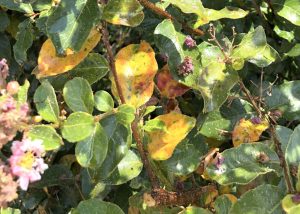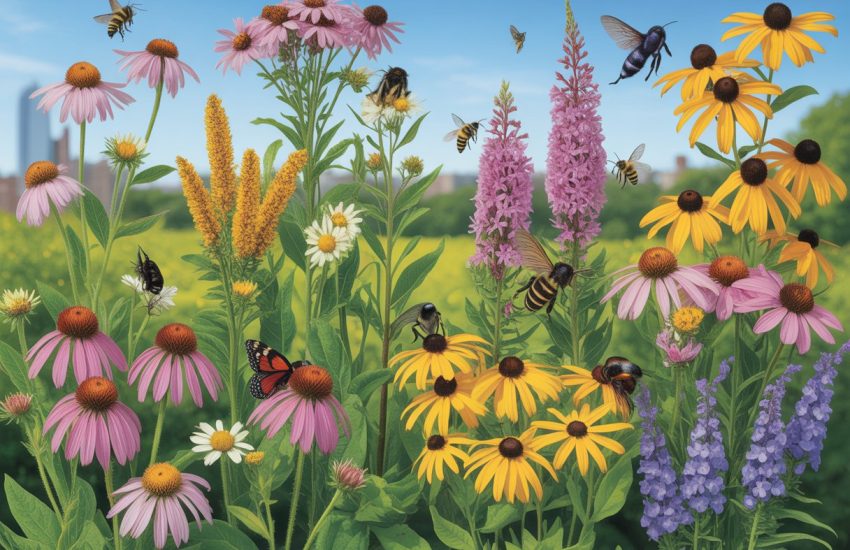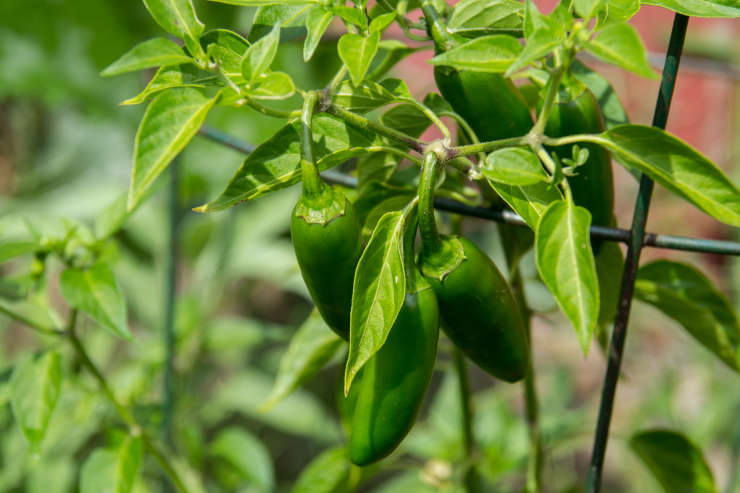7 Reasons Why Crepe Myrtle Leaves Turn Yellow
If your crepe myrtle tree leaves are turning yellow, you may be worried that it could be dying. Yellowing leaves could represent a range of different problems, and it is important that you know which one is affecting your trees.
1. Water
The leaves of a healthy crepe myrtle will be dark green on the top side and lighter green on the bottom side of each leaf. If you notice your crepe myrtle’s leaves turning yellow or brown, this could indicate that it needs more water.
The color of the leaves can tell you how much water is available to your tree. The greener the leaf, the more moisture there is in it; therefore, the greener it will appear when compared to other plants with less moisture in their leaves. Yellowing leaves indicate that there is not enough water available for your plant.

Too much water
If your tree is getting too much water, the leaves will turn yellow. Crepe myrtles do not like wet feet and will rot if they sit in standing water for too long. They also need good drainage so that water does not pool around the base of the trunk or roots. If you live in an area with clay soil, this may be more of a concern than if you live in sandy soil where it drains well naturally.
If you have been watering your tree too much or have recently planted it in an area where it gets too much water, try pruning back some of the branches to give them more room to breathe. You can also plant it in another location where it will get less water or try adding some mulch around its base to help keep moisture away from its roots.
Too little water
If your crepe myrtle is getting too little water, then it can cause the leaves to turn yellow and fall off. This is especially true if they were planted in an area where they didn’t get enough water during the summer months or if they were planted in a pot that did not drain well and had water sitting in it for too long. If this is the case for you, then simply watering more often should solve this problem quickly because it will help to replenish nutrients in the soil as well as rehydrate them so they can start producing new leaves again.
Impurities in water
Crepe myrtles are extremely sensitive to impurities in the water they are growing in. The leaves will turn yellow, then brown and fall off. The problem is that these impurities can be hard to identify.
The first thing to check is your water source. If you use a well, it might be drawing in minerals from the soil or rocks close to the wellhead. A city water supply may have high levels of chlorine or other chemicals added to kill bacteria and viruses. Both of these can cause leaf discoloration in crepe myrtles.
If you suspect your water quality is causing the yellowing leaves, try adding some charcoal-based filtration system such as an activated carbon filter or reverse osmosis system for drinking water at home. You could also try adding organic fertilizers like fish emulsion or seaweed extract directly onto your soil around your crepe myrtle instead of using them as fertilizer sprays on top of the leaves, which may not get all the way down into the roots where they are needed most.
2. Age
This is a common problem with this tree, especially if the tree is older than 15 years old. The leaves will start turning yellow and falling off.
The reason for this is because there is an imbalance in the nutrients that are given to the tree. When you give too much nitrogen to the tree, it will have an excess of chlorophyll production, and this will cause the leaves to turn yellow and fall off. If there is not enough nitrogen in the soil, then you will notice that your trees have weak branches and fewer green leaves than normal.
The best way to fix this problem is by getting rid of all of the dead branches from your tree and giving it proper care by adding more nitrogen-rich fertilizer into its soil.
3. Pests
Aphids
Aphids are small, soft-bodied insects that are often green but can also be yellow, pink, or black. They feed by inserting their long, tube-like mouth parts into a plant and sucking out the juices. Aphids are known to transmit plant viruses with their piercing-sucking mouthparts. The honeydew they produce as they feed may encourage the growth of sooty mold on the leaves. Soil-borne diseases may also be spread by aphids feeding on weakened plants. Aphid infestations usually occur during the spring and summer months when temperatures are warm, and plants are actively growing. Aphids prefer tender new growth and blossoms of many woody ornamental plants (such as crepe myrtles). They can also attack young stems producing deformed growth or stunting.
Scale
Scale insects feed on the sap in the leaves, twigs, and branches of the crepe myrtle. They suck nutrients from these parts of the plant and deposit their excrement on the leaves, which causes them to turn yellow. The scale insects themselves appear as small bumps on the surface of the leaves or stems.
Mites
Mites are tiny arachnids that live on the underside of leaves, sucking plant juices from the leaves. They range in color from white to red, blue, and black. Mite infestations usually cause damage during hot summers when plants are stressed for water and nutrients. The best way to control mites on crepe myrtles is to spray the foliage with insecticidal soap or neem oil every two weeks during the summer months.
Mealybug
Mealybugs are small insects that suck sap from plants and secrete a waxy substance called honeydew on which sooty mold grows. They tend to attack newer growth at first, then move upward along the stems until they reach the top of the plant, where they congregate under protective flaps of bark or in leaf axils (where new buds emerge). Damage includes wilting, deformed leaves, and dying branches. You can apply dormant horticultural oil in early spring before new growth emerges if you see mealybugs in winter or early spring; otherwise, treat weekly with insecticidal soap.
Whiteflies
Whiteflies are very small flying insects that resemble tiny moths. Adult whiteflies have four wings and clear bodies with white wings; however, their larvae look similar to maggots with clear bodies and blackheads. There are two types of whiteflies: sweetpotato wireworms (Bemisia tabaci) and silver leaf whitefly (Bemisia argentifolii). Sweetpotato wireworms feed on roots of grasses and weeds; however, Silverleaf whitefly feeds on the foliage of trees, shrubs, and vines, causing damage to fruit trees as well as ornamental plants like crepe myrtles.
4. Disease
Phyllosticta Leaf Spot
Phyllosticta leaf spot is the most common disease that affects crepe myrtles. It produces small, round or oblong spots on the leaves that are initially yellow to brown and then become olive green to black. Later on, the spots turn into sunken areas surrounded by a dark brown ring. The fungus that causes phyllosticta leaf spot overwinters in fallen leaves and spreads through rain splashing onto new growth during the growing season. It’s important to remove infected leaves as soon as you see them, so they don’t spread the spores to other parts of the plant.
Myrothecium Leaf Spot
Myrothecium leaf spot is caused by Myrothecium roridum, a fungus that overwinters on infected leaves and produces spores in early spring. It is most common on young plants but can occur any time of year if conditions are favorable for the growth of the fungus. Infected leaves develop yellow spots with purple borders (margins) that later turn brown or black as they age. As the infection spreads to new leaves, they will develop brown spots that eventually grow together to form large lesions on the upper and lower surfaces of leaves as well as stems.
Cercospora Leaf Spot
Cercospora leaf spot is a common disease caused by the fungus Cercospora crepe myrtle. This fungus overwinters in leaf litter and can cause significant damage to your crepe myrtle. The spots are circular, yellow-orange with a dark center, and occur on the upper leaf surface. Leaves may turn yellow or brown, curl and drop prematurely. Infected leaves often have a water-soaked appearance.
Bacterial Leaf Blight
Bacterial leaf blight is a common disease that affects crepe myrtles. It causes brown or black spots to form on the leaves and eventually kills them. The spots may also have white, powdery spores on them. This fungus is spread by splashing water and wind, so it’s important to keep your tree well-watered but not overwatered during dry periods. Prune off affected branches when they die back in winter to help prevent the spread of the disease.
Powdery Mildew
Powdery mildew is another common disease that affects crepe myrtles in late summer or fall. It appears as white or gray powdery patches on the top of leaves; underneath these patches, leaf veins remain green while the rest of the leaf turns yellow and eventually dies off completely if left untreated. Treating with fungicide can help prevent this disease from spreading further; applications should be made early in the season before symptoms appear for best results.
5. Soil health
The leaves of your Crepe Myrtle may turn yellow because they lack nutrients such as nitrogen (N) and potassium (K). To correct this problem, apply fertilizer at half strength when watering your tree or shrub. The type of fertilizer that works best depends on what kind of soil you have; sandy loam soils require more nitrogen while clay soils need more potassium.
The pH level of soil determines whether the nutrients plants need for growth are readily available or locked up by chemicals in the soil. A pH level that’s too high or too low makes it difficult for plants to absorb nutrients. A reading below seven indicates acidic soil, while readings above seven indicate alkaline soil. You can test your soil’s acidity with a kit from your local hardware store or nursery. If you notice that your crepe myrtle leaves are turning yellow, especially if the entire leaf turns yellow rather than just part of it, it could be a sign that your soil needs more lime or sulfur to improve its pH level.
6. Overfertilization
Over-fertilization can cause the leaves of the crepe myrtle to turn yellow or brown. This is because the plant is not able to absorb all of the nutrients that are being added to it. In most cases, this is caused by adding too much fertilizer at one time. If you add too much fertilizer, it will build up in the soil and prevent access to other nutrients, such as nitrogen and potassium. The best way to avoid over-fertilization is to use slow-release fertilizers instead of liquid ones. These types of fertilizers slowly release their nutrients over time, so there is no chance of overfeeding your plants.
7. Soil drainage
Soil drainage can cause roots to rot, and root death can result in yellowing leaves. Poor drainage occurs when the soil becomes too compacted or when there aren’t enough air pockets available for root growth within the soil profile. To improve drainage, amend your soil with organic matter such as composted manure or aged sawdust before planting your new tree, so it has plenty of moisture-retaining organic matter to help keep it moist during dry periods without getting waterlogged during rainy seasons.
While crepe myrtle trees are one of the most commonly grown trees in the Southeastern part of the United States, there are several reasons why crepe myrtle leaves may change colors. These leaves will first turn light green, then yellow or brown as they age and naturally fall from the tree. Understanding the underlying cause can help determine if you should do anything to prevent further leaf drop.


